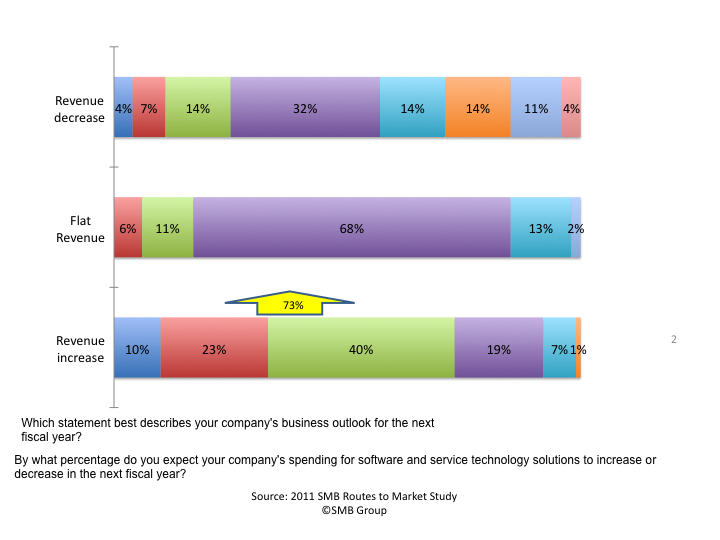Mobile Business Apps
The Technology-Performance Connection for Midmarket Businesses

In today’s always-on, hyper-connected world, technology has become a critical lynchpin for business success. Increasingly, businesses of all sizes view technology as an essential to improving customer engagement, raising employee productivity, and creating innovation and differentiation—all vital ingredients for building economic value.
You don’t need to take my word for it. For the first time since IBM began conducting its Global CEO Study eight years ago, study respondents identified technology as “the most important external force impacting their organization” in the most recent 2012 IBM study.
It looks like these respondents are right. In the SMB Group’s 2011 SMB Routes to Market Study, we identified a distinct category of midmarket companies that we’ve termed “Progressive SMBs.” Despite or perhaps because of economic uncertainties, Progressive SMBs invest more in technology and have higher revenue expectations than peers whose tech investments are flat or declining. For instance, 73 percent of midmarket companies (medium businesses with 100 – 999 employees) that plan to invest more in technology anticipate revenue increases in 2012, compared to just 17 percent among those planning to decrease IT spending. Progressive SMBs view technology as a vital tool for business transformation, a mechanism to create market advantage, and a way to level the playing field against bigger companies.
Figure 1: Increased IT Investments Pay Off For Midmarket Businesses

As a result, Progressive midmarket companies can leverage key technology trends to fuel better business returns. As they do, they make the case for the value of these technologies, and in turn, will spark broader adoption across the midmarket spectrum.
Cloud Computing and Virtualization Become the New Normal
The pace of technological change is in overdrive, and the requirement to harness technology-based solutions to gain market advantage is rising. As a result, demand for cloud-based solutions is accelerating (Figure 2). The business application areas that show the strongest near-term potential for midmarket cloud growth are marketing automation, business intelligence/analytics, and collaboration.
Figure 2: Applications Moving to the Cloud

The promises of cloud computing—reduced capital costs, speed to deploy, real-time collaboration and data visibility—tap into key midmarket business needs and constraints. By offloading deployment, management and support to a cloud service provider, midmarket businesses can free up internal resources to focus on core business requirements. Users can reap the benefits of anytime, anywhere, any device access to applications. And, companies can achieve solution benefits more quickly than if they had to vet, buy, install and deploy a new solution in-house.
But that doesn’t mean everything will go to the public cloud; it will continue to be a hybrid world for a very long time. Many midmarket businesses will continue to choose on-premises apps as security, regulatory, customization or other needs dictate, but will turn to desktop and server virtualization solutions to gain benefits similar to the public cloud. With IT staffs stretched thin, midmarket businesses will turn to managed service providers (MSPs) to offload IT infrastructure planning, implementation and management more frequently.
Mobile Mania Accelerates
The growth of smart mobile devices and applications has been nothing short of spectacular. The SMB Group’s 2012 SMB Mobile Solutions Study shows that 81 percent of midmarket businesses already equip their employees with mobile devices and solutions–and the other 19 percent plan to do so within the next 12 months.
Midmarket businesses want to give employees more and better mobile solutions to boost productivity, streamline information access and improve customer service(Figure 3). With use of mobile collaboration apps (email, calendar, etc.) is already mainstream, these companies are now deploying customer relationship management, social media marketing, time management, and field service apps.
Figure 3: Top Drivers and Obstacles For Mobile Solutions

They are also ramping up external mobile application development to interact with customers, partners and suppliers. External-facing mobile apps in areas such as mobile marketing, payments, scheduling and customer service apps help businesses improve customer responsiveness, grow revenue and streamline service.
However, mobile apps also creates several challenges. With limited IT resources and mobile expertise, many midmarket businesses need outside help to ensure security, manage mobile applications and devices, and integrate new mobile apps with their existing business solutions.
The Social Imperative Grows
Social network-based technology has grown from curiosity to niche to new paradigm in a very short time, and is becoming indispensable to many midmarket businesses. According to our 2012 SMB Social Business Study, social media use among midmarket businesses increased to 63 percent in 2012–up from 52 percent in our 2011 study.
Use of social tools is already exceeding that of purpose-built software for functions such as to “connect with people who aren’t customers” “generate more web site traffic” “generate more/better interaction with customers/prospects” and “new employee recruitment,” as shown in Figure 4.
Figure 4: Social Media Use Gaining Ground for Accomplishing Many Business Functions

But, while social media use is up, the percentage of midmarket businesses taking a planned, strategic approach has pretty much remain stuck. 51 percent of midmarket social media users still pretty much throwing the proverbial spaghetti on the Facebook wall—or into the Twitter stream. This is a critical distinction because strategic users are significantly more satisfied with the outcomes they get from their social efforts than counterparts with an ad hoc approach.
For instance:
- 62 percent of strategic users, compared to 42 percent of informal users are very satisfied with social to “improve market awareness/reputation.”
- 55 percent of strategic users, compared to 45 percent of informal users are very satisfied with social to help them “connect with people who aren’t customers.
- 58 percent of strategic users, compared to 28 percent of informal users are very satisfied with social to help “generate more leads.”
As midmarket businesses invest more time and money into social efforts, the need to incorporate social into corporate planning in a more strategic way will increase. Midmarket businesses will need guidance to select the best tools for their requirements, train employees, integrate social with business solutions, monitoring social interaction, and measuring return on social initiatives.
Turning the Information Explosion into A Fountain of Wisdom
Many SMBs have plenty of data, but find it challenging to get the insights they need from it. The social-mobile-cloud triumvirate adds more fuel to the data explosion. In our 2011 SMB Routes to Market Study, respondents cited “getting better insights from the data we already have” as a top technology challenge.
To plow through the growing data avalanche, businesses are beefing up their intelligence investments. 29 percent of midmarket businesses purchased/upgraded a BI solution within the past 24 months, and 28 percent plan to do so in the next 12 months. The need will only grow as midmarket companies integrate new customer and prospect data from social media into the information flow of existing business solutions to bring market and individual customer trends, requirements and behavioral patterns into sharper focus.
Getting the Job Done
The ability to strategically apply cloud, mobile, social and business intelligence solutions to their businesses will increasingly distinguish high-performance midmarket businesses from lesser perfuming counterparts. But with an average full-time IT staff of eight, most midmarket businesses simply don’t have the staff, expertise or budget for do-it-yourself IT in these areas. These IT shops have their hands full simply grappling with the day-to-day problems of their current IT environment.
However, these midmarket challenges offer managed service providers (MSPs) and other solution providers with ample opportunity to provide these businesses with a broader portfolio of automated, integrated managed services for both infrastructure and business application requirements, along with professional services guidance and training. In our next post, I’ll explore some of these opportunities in more detail.





